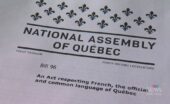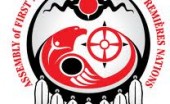Re Ian Bremmer 'Could third-party candidates upend the 2024 US election?' 3 April The current political movement in the USA…
Canada and The First Nations — Treaty relationship must evolve
Written by Diana Thebaud Nicholson // January 4, 2013 // Canada, Government & Governance // Comments Off on Canada and The First Nations — Treaty relationship must evolve
We believe this background is too important to lose through a broken link or other problem, so publish it in full.
Op-Ed: The treaty relationship must evolve
By Richard Van Loon*, Ottawa Citizen
The banner heading of the Idle No More web page reads:
“Idle No More calls on all people to join in a revolution which honors and fulfills Indigenous sovereignty which protects the land and water. Colonization continues through attacks to Indigenous rights and damage to the land and water. We must repair these violations, live the spirit and intent of the treaty relationship, work toward justice in action, and protect Mother Earth.”
Samuel de Champlain would have understood.
Four hundred years ago, on May 27, 1613, Champlain left Montreal heading, for the first time, up the Ottawa River, which he called the River of the Algoumequins. The next day he met 15 canoes of the “Quenogebin Nation,” who also lent him a guide. When he passed what we call the Gatineau River, his guide informed him that the “Petite Nation des Ouesharini” lived there. He met another Algonquin nation, the Matou-ouesharinia on Lac des Chats and another group at Muskrat Lake. His outward journey ended June 10 at Allumette Island after a meeting with the Algonquin war chief Tessouat, a man much respected by Champlain and, in those days, at least as famous throughout the Ottawa-St. Lawrence valleys as Champlain himself.
Champlain always referred to the various tribal groupings he met as nations, a term used continuously by European colonists until the mid-19th century. Champlain knew, as did anyone who ventured across North America over the next 250 years, that these nations controlled the territories, were essential to the travellers’ survival, had to give permission for the presence of outsiders and deserved respect.
After the conquest of New France by Britain, the British government saw fit to issue a Royal Proclamation governing the relationships between “the several Nations or Tribes of Indians with whom We are connected, and who live under our Protection.” The proclamation went on to say “if at any Time any of the Said Indians should be inclined to dispose of the said Lands, the same shall be Purchased only for Us, in our Name, at some public Meeting or Assembly of the said Indians.”
What does this have to do with the Idle No More movement? Well, the indigenous sovereignty and the treaty relationships to which Idle No More refer have their roots in these historical facts and in a deep historical relationship too often ignored today.
In fact, treaties of one kind or another were a feature of First Nation-European relationships almost from the start. Initially they were oral undertakings, but not less valid because of that. Later, by the start of the 18th century, Europeans were inclined to write down what they called treaties of Peace and Friendship. For the First Nations, oral undertakings were usually sufficient and, as long as the power balance between the two sets of civilizations was equal or favourable to the First Nations, they worked well enough.
But times changed. Pestilence decimated First Nation populations. The fur trade declined. The buffalo disappeared. Starvation and hardship threatened. The terrible example of Americans killing thousands of Indians south of the border frightened those to the north. And population pressures from the east and Europe as well as desire for resources on First Nation lands all conspired to tilt the balance. The great period of land cession and treaty signing was about to begin.
There had been about 30 land treaties in Upper Canada before Confederation. Most were negotiated in accord with the Royal Proclamation to free up land for settlers. They were often made hastily and without First Nations understanding of what they surrendered. Misunderstandings inevitably arose and often persist to this day, not least since governments often did not respect even the written texts they had promulgated.
The first major treaties west of Upper Canada were the Robinson Huron and Superior Treaties of 1850. Motivated by the discovery of mineral deposits north of the upper lakes and by the difficult situation of the northern Ojibway tribes, the Robinson treaties covered the lands between the upper lakes and James Bay watershed, creating a template followed in treaty signings across the west and still, in some important ways, followed today.
Then, between 1871 and 1906, 10 “numbered treaties” were quickly negotiated, covering all of Manitoba, Saskatchewan and Alberta. Treaty 11, covering parts of the Northwest Territories, was completed in 1921. In all of these, First Nations were required to “cede, release, surrender and yield up to the Government of the Dominion of Canada, for Her Majesty the Queen and Her successors forever, all their rights, titles and privileges, whatsoever, to the lands included within the following limits” in return for land, money, equipment, supplies, some services such as schools and the “right to pursue their avocations of hunting and fishing throughout the tract.”
For years afterwards, more remote bands continued to join these treaties. For example, Chief Theresa Spence’s band, Attawapiskat, did not adhere to Treaty 9 until 1935.
All these treaties have been bedevilled by problems. Governments sold off reserve land to outsiders, often without adequate consultation with residents. Treaty land entitlements were not always fulfilled, or the land provided was not that agreed upon. Resource revenues from reserve lands, supposed to be managed in trust by government for the benefit of residents, were mismanaged. Since explanations to First Nations about what treaties entailed were often incomplete or even deliberately misleading, misunderstandings were frequent.
A particularly vexatious example now revolves around the commitment that First Nations will continue to have the “right to pursue their avocations of hunting and fishing throughout the tract” that is, on their traditional lands. This right is central to First Nations’ identity but can be meaningless if land and water quality are not protected. So it is hardly surprising that the issues at the heart of the Idle No More movement include the current government’s declaration that most waters formerly protected under the Navigable Waters Protection Act will no longer be protected, as well as its other environmental failings.
These problems, particularly as they relate to reserve land, have led to a vast number of legal claims and to a “specific claims” process with a formal negotiating protocol. But hundreds of claims remain unresolved. While both sides can be at fault, the lack of resolution can be much more important to the First Nations than to government. Understandably, frustration frequently boils over.
Since 1982, treaty and aboriginal rights have been constitutionally protected. While this sounds impressive and while the courts have more often than not sided with First Nations, constitutional protection has often meant much more to First Nations than governments are willing to concede.
Meanwhile much of Canada, including most of B.C., much of the North and, perhaps surprisingly, much of the Ottawa Valley, was not covered by early treaties. A modern treaty process called Comprehensive Claims has therefore evolved. It has had some important successes starting with the James Bay and Northern Quebec Agreements in 1975 and continuing through much of the Northwest Territories, Yukon, Nunavut and coastal Labrador. The recent agreement in principle with Ottawa Valley Algonquins is also an important step toward a modern treaty.
But the Comprehensive Claims process is also problematical. First, most of B.C. is not yet covered. Hence aboriginal title and rights, terms subject to much debate, apply to most of the province. Resource development of many kinds, including pipelines, probably cannot proceed without extensive consultations with First Nations and, probably some form of their consent.
Second, the process is terribly slow and expensive: even successful agreements can take decades. This can be frustrating, but it must be understood that the entire lives of First Nation and Inuit peoples are bound up in these agreements, the legalese is unfamiliar to most of those affected and the requirement to give up rights can be frightening. Of course, First Nations will move with great caution, especially since the record of non-native compliance is less than stellar.
Third, a modern Comprehensive Claim agreement can be hundreds of pages long and negotiations can involve thousands of hours of consultation and explanation. With so much detail, and with such great importance to all those involved, disagreements are frequent.
Fourth “final agreements” are not always ideal in changing circumstances. Even the most recently negotiated agreements are subject to demands for changes. And not surprisingly, court challenges are not uncommon.
So, what is to be done?
First, we should not be surprised that disagreements occasionally boil over into demonstrations. They are a legitimate way for people who feel, often correctly, that their rights are not recognized by governments which often do not share their sense of either the importance or the urgency of dealing with problems. First Nation demonstrations will be a feature of the Canadian landscape and as long as grievances persist.
Second, we must recognize that many, though certainly not all, of the grievances are legitimate. They will never all be resolved, but we must continue to work at them.
Third, while the federal government acknowledges its formal responsibility for treaties and on reserve First Nations people, it does not usually recognize what this entails. These are the federal government’s special citizens. Hiving off responsibility for them in one or two departments with the prime minister making occasional cameo appearances is not enough. Certainly, his agreement to meet with a delegation of First Nations leaders on Jan. 11 is promising, provided he really remains for “a working meeting.”
But most important, governments and non-First Nation citizens must understand that the First Nation view of treaties is different and, in some ways, more defensible and realistic than ours. Governments love certainty and so view treaties as a “deal.” It is negotiated and finalized. Then it is over and done.
First Nations and Inuit view treaties as a relationship between them, the original nations of North America and later arrivals. The relationship requires constant work and must evolve with circumstances. It is never settled: it is simply ongoing. If governments and non-aboriginal society can recognize that relationship with generosity and flexibility, we will live better together.
*Richard Van Loon is a former associate deputy minister for Indian Affairs and Northern Development.


